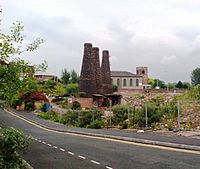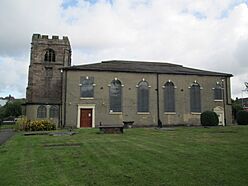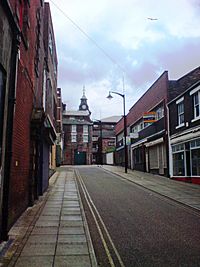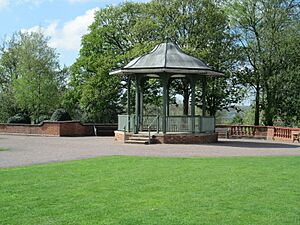Burslem facts for kids
Quick facts for kids Burslem
|
|
|---|---|
| Federated town and district | |
|
|
| Population | 6,940 (2021 Census) |
| OS grid reference | SJ875495 |
| Unitary authority | |
| Ceremonial county | |
| Region | |
| Country | England |
| Sovereign state | United Kingdom |
| Post town | STOKE-ON-TRENT |
| Postcode district | ST6 |
| Dialling code | 01782 |
| Police | Staffordshire |
| Fire | Staffordshire |
| Ambulance | West Midlands |
| EU Parliament | West Midlands |
| UK Parliament |
|
Burslem (/ˈbɜːrzləm/ BURZ-ləm) is one of the six towns that along with Hanley, Tunstall, Fenton, Longton and Stoke-upon-Trent form part of the city of Stoke-on-Trent in Staffordshire, England. It is often referred to as the "mother town" of Stoke on Trent. The population of the town was included under the Burslem Central ward and had a population of 6,490 in the 2021 Census.
Contents
Topography
Burslem is sited on the eastern ridge of the Fowlea Valley, the Fowlea being one of the main early tributaries of the River Trent. Burslem embraces the areas of Middleport, Dalehall, Longport, Westport, Trubshaw Cross, and Brownhills. The Trent & Mersey Canal cuts through, to the west and south of the town centre. A little further west, the West Coast Main Line railway and the A500 road run in parallel, forming a distinct boundary between Burslem and the neighbouring town of Underlem (Newcastle-under-Lyme). To the south is Grange Park and Festival Park, reclaimed by the Stoke-on-Trent Garden Festival.
History
The Domesday Book shows Burslem (listed as Bacardeslim) as a small farming hamlet; strategically sited above a vital ford (crossing) at Longport, part of the major pack horse track out of the Peak District and Staffordshire Moorlands to the Liverpool/London road. As far back as the late 12th century a thriving pottery industry existed, based on the fine & abundant local clays. After the Black Death, Burslem emerges in the records as a medieval town - the 1536 stone church is still standing and in use. Until the mid-1760s Burslem was relatively cut off from the rest of England; it had no navigable river nearby, and there were no good & reliable roads. By 1777 the Trent and Mersey Canal was nearing completion, and the roads had markedly improved. The town boomed on the back of fine pottery production & canals, and became known as 'The Mother Town' of the six towns that make up the city. In 1910 the town was federated into the county borough of Stoke-on-Trent, and the borough was granted city status in 1925.
Many of the novels of Arnold Bennett evoke Victorian Burslem, with its many potteries, mines, and working canal barges. The Burslem of the 1930s to the 1980s is evoked by the paintings and plays of Arthur Berry.
Burslem contains Britain's last real working industrial district (i.e.: where people live within walking distance of the factories of a single heavy industry - in this case, the potteries); and thus much of the nineteenth-century industrial heritage, buildings & character have survived intact.

A recent report suggested the concentration of pottery-based heritage makes the area the richest stretch of canal for industrial heritage in England.
Population and housing
At the 1991 census count, the population of Burslem was 21,400. A study by consultants Atkins, working from the United Kingdom Census 2001 data, showed that the Burslem population is steady and has not declined despite a manufacturing decline during the 1980s and '90s.
Traditional Victorian architecture and Edwardian period terraced houses dominate the town. New housing developments are underway on the Sadlers Factory site and around Woodbank Street.
Heavy industrial employment (mines, steel and pots) has left a legacy of ill-health among many older people, but there is the Haywood Hospital (High Lane, Burslem) and the new £300-million University Hospital of North Staffordshire is just three miles away by road.
There were two electoral wards covering Burslem at the 2011 census, Burslem Central and Burslem Park.
At the 2011 census the ethnic demographics of the Burslem Central ward were:
| White British and White Other | 83.5% |
| Asian / Asian British | 9.0% |
| Mixed / multiple ethnic groups | 2.7% |
| Black / African / Caribbean / Black British | 2.3% |
| Other ethnic group | 1.0% |
At the 2011 census the ethnic demographics of the Burslem Park ward were:
| White British and White Other | 90.3% |
| Asian / Asian British | 5.50% |
| Mixed / multiple ethnic groups | 1.92% |
| Black / African / Caribbean / Black British | 1.38% |
| Other ethnic group | 0.8% |
Economy
Industrial scale pottery production has drastically declined since the 1970s; but specialist makers (Steelite) and smaller producers of high-value ceramics (Burleigh, Wade, Moorcroft) are thriving. Burslem is emerging as a centre for small, freelance creative businesses working in sectors such as fine art, animation and crafts as well as pottery.
The number of shops in the town centre have markedly declined, hit by the impact of nearby out-of-town retail parks that offer free parking. However, the evening economy is still active with a wide range of bars and restaurants mainly serving English and Indian food.
The Market Hall, a Grade II listed building dating from 1879, lying between the market place and Queen Street, was in use until 2003, closing after its condition was judged unsafe.
At Spring 2002 unemployment was 4.1% or 1,526 people in the Stoke-on-Trent North constituency; almost the same rate as the West Midlands as a whole. In Burslem at 2001 unemployment was 3.2% and declining.
In 2005, the building of business park units in the town. Further business parks are planned for 2006/7 just to the north in Chatterley Valley, and the south in Etruria Valley.
In 2019 it was reported that the town's last bank had closed, leaving the town without any free to use cash machines, making it the first large town in the UK without one.
Media
Local television services is provided by BBC Midlands Today and ITV News Central.
Local radio stations are BBC Radio Stoke, Hits Radio Staffordshire & Cheshire, Greatest Hits Radio Staffordshire & Cheshire, 6 Towns Radio and HitMix Radio, a community based radio station.
In 2007 a social enterprise newspaper, Local Edition, become one of the first newspapers to cover the area regularly. The newspaper covered Burslem, as well as surrounding areas including Tunstall, Middleport and Cobridge, giving a voice to the people in the community. The newspaper ceased publication in 2008 and its archive is online.
Leopard Inn
The Leopard public house, also known as the Leopard Inn, dates to the late 18th century. The building was refronted about 1830 and expanded in the 1870s with the addition of more than 50 bedrooms in the rear. In 1765 it was the location of the first meeting between Josiah Wedgwood, Thomas Bentley, Erasmus Darwin and James Brindley to discuss the building of what became the Trent and Mersey Canal; as The Tiger, it appears in several of Arnold Bennett's "Five Towns" novels. It was a coaching inn and after the rear extension, a major commercial hotel, but reduced demand for rooms led to the extension being closed off in 1956. The rediscovery of this section of the building in 2007 led to tales of hauntings and ghost tours.
Bass Breweries bought The Leopard in 1965 and renovated the restaurant, which they named the Arnold Bennett Suite. The building was Grade II listed on 18 April 1972. In the 21st century it became a live music venue and was extensively renovated, but it did not reopen after the COVID lockdown. In January 2021 it was sold to a development company who proposed redeveloping the rear into luxury apartments while retaining the pub; in February 2021 Stoke-on-Trent City Council declared it an Asset of Community Value. ..... The city council announced the formation of a Heritage Congress to protect historic properties in Stoke-on-Trent. In June 2024, the owners submitted a proposal to convert the building to a shop and 17 one-bedroom assisted living flats.
Tourism
Around 5 million tourists visit Stoke-on-Trent each year, supporting around 4,400 direct jobs. Stoke shows its popularity through the number of repeat visits; around 80 per cent of visitors have previously been here. Burslem has a variety of strong tourist attractions; Burleigh, Moorcroft, Festival Park, its many pubs, and the Trent & Mersey Canal. The Old Town Hall is one of the largest buildings in Burslem.
It also has the legacy of novelist Arnold Bennett, who refers to the town and many of its streets with thinly disguised names: e.g. Burslem/"Bursley", Swan (Square and Pub)/"Duck". It is the setting for one of his most famous works, the Clayhanger trilogy. Burslem's centre benefits from having an almost-intact medieval street-plan and countless fine old buildings, and a townscape which almost-totally escaped re-development during the 1960s and 1970s.
After being under-used for years, the Burslem School of Art has been refurbished at a cost of £2.1m and offers several large free art galleries. The free Public Library is currently based in the School of Art, after the Venetian Gothic Wedgwood Institute closed for safety reasons early in 2009. Ceramica was a new award-winning ceramics family attraction, based in the imposing old Town Hall and funded by Millennium Lottery money but due to the loss of council funding has been closed. The Queen's Theatre has regular concerts and an annual pantomime.
There is a traditional Friday street market, and street carnivals in May and December.
Sports
The major football club Port Vale is based in Burslem at Vale Park. The team currently plays in League Two, England's fourth division.
Near to the town is Burslem Golf Club, a 9-hole course which once had singer Robbie Williams as a Junior Captain. It was opened on 28 September 1907 by vaudeville entertainer and golfer Sir Harry Lauder. On 29 September 2007 his great-nephew Gregory Lauder-Frost as guest-of-honour rededicated it for another century in a formal ceremony.
Professional darts player Phil Taylor is from Burslem.
Education
Burslem is the site of one of the two campuses of Stoke-on-Trent College; the College states that it is the largest Further Education college in Stoke and North Staffordshire. The campus specialises in media-production and drama. Stoke Studio College, a studio school for 13- to 19-year-olds opened at the college campus in September 2013.
Within a six-mile radius from Burslem there are three universities; Staffordshire at Shelton, Keele University, and Manchester Metropolitan's large Art & Design campus at Alsager.
The environment
The town is elevated and is not prone to flooding.
Parks
Burslem Park
The town's municipal park, designed by the landscape architect Thomas Hayton Mawson, was opened in 1894. It is protected by a Grade II* designation on the Register of Parks and Gardens. It was laid out on derelict land next to the Potteries Loop Line. Mawson also used reclaimed land as the site of Hanley Park, which he designed around the same time. Both parks include water features.
Other parks
There are also later examples of reclaimed green space near Burslem, such as the Westport Lake, a 1970s project, and the legacy of the 1986 National Garden Festival, which imaginatively reclaimed part of the site of the Shelton Bar steelworks.
The Peak District National Park begins just ten miles north-east of Burslem.
Burslem cemetery
The cemetery, to the east of Sneyd Hill Park, was laid out in 1879 as a combined burial ground and recreational park. It covers 11.4 acres, and comprised walks, rides, lodges and a chapel, situated at the centre. The chapel was demolished by the council in 2008 on the basis of lack of use and the costs of maintenance and repair. The ashes of the novelist Arnold Bennett were interred in his family tomb in the cemetery, following his death in 1931.
Transport
The nearby A500 gives access to the M6 motorway. Longport railway station offers direct connections south into Stoke, east to Derby and Nottingham, and north to Crewe and Manchester. The town is straddled by two major off-road cycle paths, part of the National Cycle Network.
The Trent and Mersey canal is said to see over 10,000 narrowboats a year using it. The former Burslem Canal was constructed in 1805 and remained open until 1961 when it was breached. The Burslem Canal was a branch of the Trent and Mersey Canal running from the junction near to Newport Lane (opposite the old steel works) through to the Furlong Lane area of Middleport.
The nearest international airports are Manchester and Birmingham; each is about 60 minutes away by train.
Burslem railway station which was opened by the North Staffordshire Railway opened on 1 November 1873 on the Potteries Loop Line. It closed in the 1960s and the site and trackbed are now a greenway.
Notable people
Burslem's most famous sons include the potter Josiah Wedgwood, the watercolour painter James Holland (1800–1870), Ian "Lemmy" Kilmister, the founder, bassist and lead singer of Motörhead, and Robbie Williams, who was a major shareholder in Port Vale and whose family are still resident in the area. Darts legend and 16-time world champion Phil Taylor was born, raised and also worked in the town.
In the 17th century, Molly Leigh was resident of the town, she was accused of being a witch before her death in 1748. Painter James Astbury Hammersley also came from Burslem.
William Clowes, one of the founders of Primitive Methodism, was born in Burslem as was John Bennett the potter. Sarah Benett (1850–1924), the Suffragette, member of the WSPU and social reformer lived in Burslem from 1894.
William Boulton's Providence Works and Foundry was based in Burslem, which designed and made the machinery that revolutionised the pottery industry in the second half of the 19th century.
See also
 In Spanish: Burslem para niños
In Spanish: Burslem para niños












